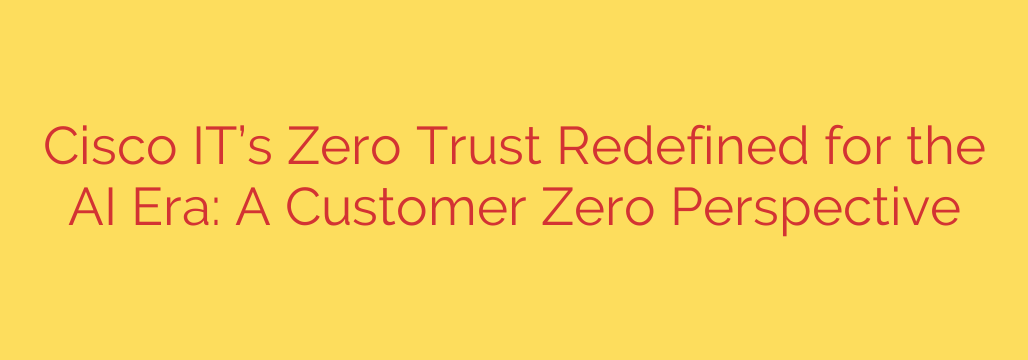
Navigating the New Frontier: Why Your Zero Trust Strategy Must Evolve for the Age of AI
For years, the Zero Trust security model has been the gold standard for cybersecurity. The principle is simple yet powerful: never trust, always verify. This approach assumes that threats can exist both outside and inside the network, so it requires strict identity verification for every person and device trying to access resources, regardless of where they are located.
This framework has served us well, but the rapid rise of Artificial Intelligence is forcing a critical re-evaluation. AI and Machine Learning (ML) workloads are not like traditional applications. They are built on distributed systems, consume massive datasets, and involve complex interactions between users, models, and infrastructure. Simply verifying a user’s identity is no longer enough to secure the entire AI pipeline.
To truly harness the power of AI without exposing your organization to new and sophisticated risks, your Zero Trust strategy must evolve. It’s time to expand the “never trust, always verify” mantra beyond just users and devices to include the core components of AI itself.
The Limits of Traditional Zero Trust in an AI World
Traditional Zero Trust focuses heavily on validating three key things:
- User Identity: Is the user who they claim to be?
- Device Health: Is the device they’re using secure and compliant?
- Access Privileges: Does this user have permission to access this specific application?
While essential, these checks fail to address the unique vulnerabilities introduced by AI. For example, how do you verify that an AI model hasn’t been tampered with? How do you ensure the data used to train a model is from a trusted source and hasn’t been poisoned? How can you secure the specialized, high-performance hardware (like GPUs) that AI relies on?
To answer these questions, a modern, AI-centric Zero Trust framework must be built on three new pillars of trust.
The Three Pillars of an AI-Ready Zero Trust Framework
A forward-thinking security approach extends verification to the foundational elements of your AI ecosystem. This creates a robust defense that protects not just the perimeter, but the entire AI lifecycle.
1. Establishing Trust in the Compute Infrastructure
AI doesn’t run on thin air. It requires powerful, often distributed, computing resources. The first step is to ensure this underlying hardware and software foundation is secure and trustworthy.
This involves verifying the integrity of the entire compute stack, from the hardware up to the cloud-native containers where AI workloads run. Key practices include using secure boot processes to ensure the system hasn’t been compromised before it even starts, leveraging confidential computing to isolate and protect data while it’s being processed, and continuously monitoring the infrastructure for any signs of tampering or unauthorized changes. Without a trusted foundation, any security measures applied on top are fundamentally flawed.
2. Ensuring the Integrity of AI Models
In the new security landscape, AI models are a new class of asset—and a high-value target for attackers. A compromised model could lead to flawed business decisions, data leakage, or unpredictable behavior.
Therefore, you must verify the trustworthiness of the AI models themselves. This means implementing strict access controls to prevent unauthorized personnel from viewing or modifying proprietary models. It also involves using digital signatures and integrity checks to ensure that the model being used for a query is the authentic, approved version and has not been maliciously altered. Protecting your models is as critical as protecting your source code or customer database.
3. Safeguarding the Data Pipeline
AI models are only as good as the data they are trained on. If malicious or biased data is introduced into the training pipeline, the model’s output can be corrupted—a threat known as data poisoning.
The third pillar is to verify the trustworthiness of the data used for both training and inference. This requires a comprehensive approach to data security, including strong encryption for data at rest and in transit. More importantly, it involves establishing data lineage to track where data comes from and how it’s been transformed. Granular access policies must be enforced, ensuring that only authorized models and users can access specific, sensitive datasets, thereby protecting data privacy and preventing a catastrophic breach.
Actionable Steps for Building an AI-Centric Zero Trust Architecture
Evolving your security posture for the AI era is a journey, not an overnight switch. Here are a few actionable tips to get started:
- Expand Your Asset Inventory: Your definition of a critical asset must now include AI models, training datasets, and specialized compute clusters. You can’t protect what you don’t know you have.
- Map the AI Attack Surface: Understand how data flows between storage, compute infrastructure, and models. Identify the points of interaction and potential vulnerabilities in your AI pipeline.
- Implement AI-Aware Policies: Your security policies need to be more granular. Instead of just asking, “Can this user access this app?” the policy should ask, “Should this specific user be allowed to query this model with this type of data from this location?”
- Leverage Automation: The complexity and scale of AI systems make manual security monitoring impossible. Use automated tools for continuous validation, threat detection, and policy enforcement across your entire AI ecosystem.
Ultimately, securing AI is not about restricting innovation—it’s about enabling it. By extending the core principles of Zero Trust to include compute, models, and data, organizations can build a resilient foundation of trust. This allows them to confidently deploy transformative AI technologies while protecting their most valuable assets from a new generation of sophisticated threats.
Source: https://feedpress.me/link/23532/17169651/how-cisco-it-is-redefining-zero-trust-in-the-ai-era-as-customer-zero








